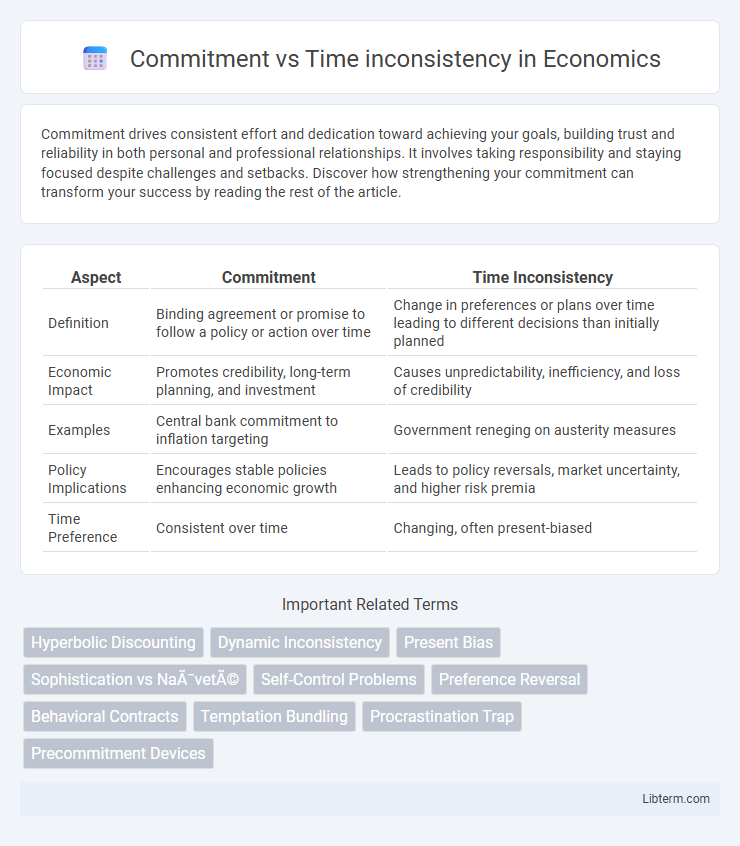Commitment drives consistent effort and dedication toward achieving your goals, building trust and reliability in both personal and professional relationships. It involves taking responsibility and staying focused despite challenges and setbacks. Discover how strengthening your commitment can transform your success by reading the rest of the article.
Table of Comparison
| Aspect | Commitment | Time Inconsistency |
|---|---|---|
| Definition | Binding agreement or promise to follow a policy or action over time | Change in preferences or plans over time leading to different decisions than initially planned |
| Economic Impact | Promotes credibility, long-term planning, and investment | Causes unpredictability, inefficiency, and loss of credibility |
| Examples | Central bank commitment to inflation targeting | Government reneging on austerity measures |
| Policy Implications | Encourages stable policies enhancing economic growth | Leads to policy reversals, market uncertainty, and higher risk premia |
| Time Preference | Consistent over time | Changing, often present-biased |
Understanding Commitment in Goal Pursuit
Commitment in goal pursuit involves creating binding intentions that align future actions with present plans, reducing the risk of time inconsistency where preferences shift over time. Understanding commitment requires recognizing mechanisms such as pre-commitment devices and clear goal setting, which help individuals maintain consistent motivation despite changing circumstances or temptations. Research in behavioral economics and psychology highlights that effective commitment enhances long-term success by minimizing impulsivity and promoting sustained effort toward objectives.
The Psychology Behind Time Inconsistency
Time inconsistency arises from psychological factors such as present bias, where individuals disproportionately value immediate rewards over future benefits, leading to decisions that conflict with long-term goals. Hyperbolic discounting explains this behavior by showing how the perceived value of rewards decreases more sharply as they are delayed, causing preference reversals over time. Understanding these cognitive tendencies enables the development of commitment devices that help align short-term actions with enduring objectives, improving self-control and decision-making.
How Commitment Impacts Long-Term Success
Commitment significantly enhances long-term success by providing a consistent framework that helps individuals and organizations resist short-term temptations and maintain focus on future goals. Overcoming time inconsistency, the tendency to favor immediate rewards over later benefits, relies heavily on strong commitment mechanisms such as contracts, habits, or self-imposed constraints. Empirical studies in behavioral economics and psychology demonstrate that higher commitment levels correlate with improved perseverance, strategic planning, and sustained achievement across various domains including finance, health, and education.
Common Triggers of Time Inconsistency
Common triggers of time inconsistency include temptation, changing preferences over time, and uncertainty about future desires or needs. Individuals often plan to act in their long-term best interest but deviate due to immediate gratification or unforeseen circumstances. This conflict between commitment and actual behavior undermines consistent decision-making and long-term goal achievement.
Commitment Devices: Tools for Staying on Track
Commitment devices are practical tools designed to help individuals overcome time inconsistency by locking in future behaviors aligned with long-term goals. Examples include automatic savings plans, pre-committed workout schedules, and app-based reminders that enforce accountability and reduce temptation. These devices leverage behavioral economics principles to maintain consistency and improve self-control in decision-making processes.
Behavioral Economics Perspective on Self-Control
In behavioral economics, commitment devices help individuals overcome time inconsistency by tying future actions to present goals, aligning short-term impulses with long-term interests. Time inconsistency occurs when preferences change over time, leading to self-control failures and procrastination. Behavioral models highlight the role of hyperbolic discounting in explaining why individuals value immediate rewards disproportionately, making commitment strategies essential for sustained self-control.
The Role of Habits in Overcoming Time Inconsistency
Habits play a crucial role in overcoming time inconsistency by automating behaviors that align with long-term commitments, reducing reliance on fluctuating short-term preferences. Establishing strong routines leverages the brain's reward system to maintain consistent actions, diminishing the temptation to deviate from planned goals. This habitual reinforcement strengthens self-control mechanisms, ensuring individuals stick to their commitments despite changing immediate incentives.
Practical Strategies to Strengthen Commitment
Practical strategies to strengthen commitment include setting clear, specific goals with measurable milestones to maintain focus and track progress. Using commitment devices such as binding contracts or public pledges increases accountability and reduces the temptation to deviate from plans. Incorporating regular self-monitoring and feedback loops helps identify time inconsistency tendencies early and enables timely corrective actions.
Recognizing and Preventing Self-Sabotage
Understanding commitment versus time inconsistency helps identify self-sabotage where immediate temptations override long-term goals, causing individuals to abandon commitments. Techniques such as setting clear, time-bound goals and implementing pre-commitment devices reduce the likelihood of inconsistency by aligning present actions with future intentions. Cognitive-behavioral strategies that increase awareness of impulsive decisions enhance the ability to maintain commitment and prevent self-defeating behaviors.
Building a Sustainable Framework for Consistency
Commitment mechanisms are essential to mitigate time inconsistency, where preferences change over time leading to decisions that deviate from long-term goals. Building a sustainable framework involves integrating credible, enforceable contracts and transparent monitoring systems to align short-term actions with enduring objectives. Leveraging behavioral insights and technology-driven tools enhances adherence to commitments, ensuring consistent progression toward sustainable outcomes.
Commitment Infographic

 libterm.com
libterm.com